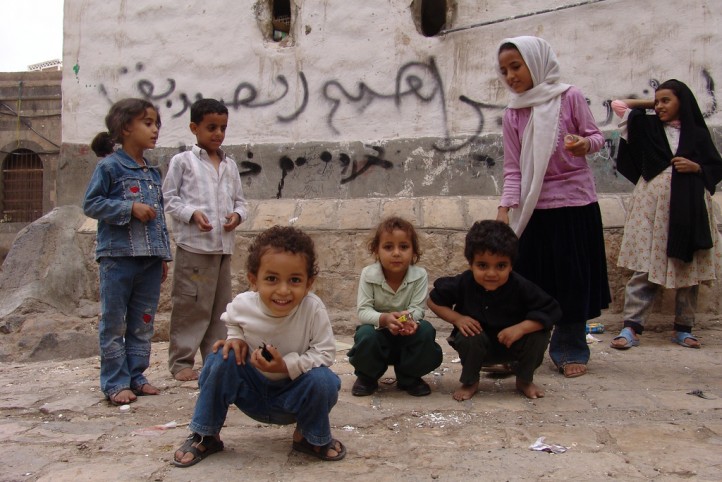by JACOB REIMANN
 Sanaa, Yemen. 2005 PHOTO/Charles Roffey/Flickr
Sanaa, Yemen. 2005 PHOTO/Charles Roffey/Flickr
Absent much stronger U.S. and European pressure on their Saudi allies, Yemen’s latest ceasefire threatens to collapse — which could mean a return to massive civilian bombardments.
On the night of January 5, a squadron of F-15 fighter jets from the Royal Saudi Air Force carpet-bombed a neighborhood in the densely populated Yemeni capital of Sanaa. Following the assault, the Al-Noor Center for the Blind lay in ruins.
“People with disabilities are being struck in their residence,” fumed Abdullah Ahmed Banyan, a patient at the facility. “Can you imagine they are striking the blind? What is this criminality? Why? Is it the blind that are fighting the war?”
The local chamber of commerce, a wedding hall, and several residential areas were also targeted by the Saudi bombs that night.
The attack, which was strongly condemned by UN Secretary General Ban Ki-moon, exemplifies two main characteristics of the brutal, scarcely reported war in Yemen: First, the U.S.-backed, Saudi-led coalition is committing massive human rights violations and war crimes. And second, that’s bringing untold suffering upon the Yemeni civilian population, pushing it ever closer to humanitarian catastrophe.
A War Is Born
The current conflict in Yemen can be traced at least back to 2014, when — after years of intermittent civil war and political chaos — rebels calling themselves the Houthis captured Sanaa and forced President Abd Rabbuh Mansur Hadi to flee to Saudi Arabia. In February 2015, the rebels launched a coup d’état and have been de facto governing the country since then.
The rebels have received support from renegade sections of the Yemeni military that are loyal to former President Ali Abdullah Saleh, himself a former foe of the Houthis. From the outside, they’re thought to be supported financially and through arms supplies from Iran, leading Saudi Arabia to accuse its rival of trying to get a foothold in the Arabian Peninsula. Under the pretense of restoring Hadi, a Saudi-led coalition supported by Western countries began the massive bombing of Yemen in March 2015.
Thrown into further turmoil by the air strikes, Yemen became an even more fertile breeding ground for Islamist groups. Al-Qaeda in the Arabian Peninsula (AQAP) — which is considered the most dangerous offshoot of the global terror network — has used the chaos to conquer cities in southern Yemen in the shadow of Saudi fighter jets. The Islamic State has also laid eyes on Yemen, attempting to contest Yemeni territory from its Islamist rival AQAP.
Tension among different Islamic denominations was never a big issue in Yemen. But increased attacks by hardline Sunni Islamic State and Saudi forces on the positions of the largely Shiite Houthi rebels — and especially on Shiite mosques — have turned a secular war more and more into an sectarian conflict between Shiites and Sunnis.
Systematic War Crimes
One of the few international journalists in Yemen, The Intercept’s Iona Craig, has painted a bleak picture of a merciless war against the Yemeni civilian population. She reported that Saudi Arabian fighter jets routinely attack densely populated residential areas, marketplaces, and civilian infrastructure.
There are no reliable records on casualty statistics, and the number of unreported cases is thought to be high. Depending on the source, they amount to several thousand dead, half of whom are civilians, and thousands more injured. Over 2 million Yemenis are internally displaced, and over 120,000 have fled to neighboring countries.
An investigation by the United Nations last summer raised alarm about the disastrous situation facing the civilian population. Four out of five people in Yemen are dependent on humanitarian aid, the report said, and about three-quarters don’t have access to safe drinking water. The UN described the situation as a “humanitarian catastrophe.”
The destruction of infrastructure and especially an accompanying naval blockade of Yemen, which cuts off the population from aid supplies and food imports, has resulted in more than half of Yemenis being food insecure. Over 300,000 children there are suffering from severe acute malnourishment — a problem worsened by the coalition’s assaults on hospitals and schools.
via Alternatives International Journal
Foreign Policy in Focus for more
